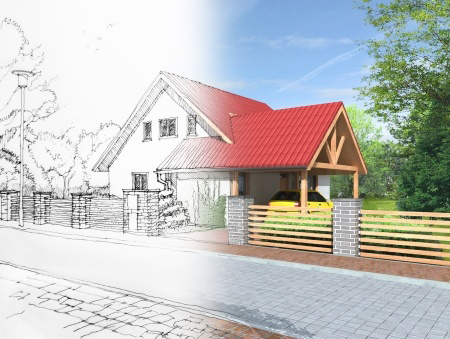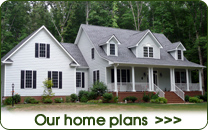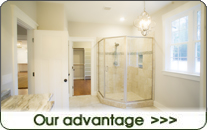 Once you’ve decided that the custom built route is right for you, you’ll face what are likely the two most important choices in the entire process: deciding on the right location and picking the right custom home builder.
Once you’ve decided that the custom built route is right for you, you’ll face what are likely the two most important choices in the entire process: deciding on the right location and picking the right custom home builder.
Both of these decisions involve making a commitment that can have long-lasting repercussions if made poorly.
With that in mind, here are the key points you should consider as you narrow down your lot search and begin vetting potential custom home builders.
Finding The Right Location For Your Custom Home
The old real estate axiom “location, location, location” holds as true when choosing a lot for a custom home as it does when looking for an existing home. What makes the best location for your custom home will depend on your family’s particular needs and specific preferences.
Often, the first step is considering any natural geographical restraints. For example, if you wish to keep your children in the same school district that they’re currently in, the area in which you must conduct your lot search will be defined for you. Similar considerations in this same vein include distance to your employer and proximity to other family.
Once the geographical boundaries for your property search have been determined, you can start considering the preferences that you and your family have regarding your ideal home site’s features.
Some families prefer to live in a quiet and more secluded area away from city centers, while others want to be in easy walking distance to shopping and other attractions. Your desire for privacy will also guide your search.
If you place a premium on privacy, choosing a wooded lot or one that is away from the busy center of a development is key. The type of view you want from your front porch and backyard is also critical; do you prefer lots of trees or a more unobstructed view?
Lastly, consider the architectural style you are leaning toward for your custom home. Certain types of architecture generally work better with different types of lots.
Homes following a traditional architectural style such as American Craftsman work better on land that is relatively flat and level. Modern or contemporary designs are often more able to easily adapt and conform to a lot that has a steep grade.
Selecting The Right Custom Home Builder
A number of factors should be weighed when trying to find the best custom home builder to create a home that meets your family’s needs. Some aspects of this decision process are fairly objective.
Begin by defining what your price range is and what size and style of home you are looking for. By doing so, you’ll naturally narrow down the field of prospective home builders as most builders tend to specialize in a certain style and price range.
Next, take a look at your prospective home builder’s past experience. A new firm isn’t necessarily a bad option, particularly if the team is made up of professionals with ample past experience.
In general, however, a strong track-record is a good indication of future successful results. In addition, examine the warranty that the builder provides on both the home and the key components therein. If something goes wrong six months down the line, you’ll want to know that it’s on your home builder’s shoulders rather than your own.
Other elements of choosing the best custom home builder for you and your family are more subjective. Ask yourself if the home builder you are evaluating has a design philosophy that meets your own.
If you find a builder who has a stellar reputation and impeccable credentials but a portfolio full of modern designs, they won’t be a great fit for you if you’re looking for a very traditional home.
Lastly, check the customer references that your home builder provides. These past clients can provide insight into the builder’s process and the end results.
One particularly revealing question that you should have on your list: would they recommend the builder to friends and family? If a home builder can’t–or won’t–provide references, that in itself is an important sign.
By looking at these criteria together, you’ll be well on your way to finding the custom home builder who best fits what you’re looking for. The right location for your family and the right home builder to meet your design needs and wants are both out there; you just have to know where to look for them.
Navigating Customizations For Your Home
Once you’ve secured the site and selected your custom builder, you must then navigate the whole host of options as you create a home that is truly customized for your family’s needs.
Many are deterred from the custom home route in the first place due to the challenge of making all of these choices. But with careful consideration, you can ensure the success of this stage in the custom home building process.
Picking the Right Features for Your Family’s Needs
One of the biggest benefits of going the custom home route is being able to choose all of the features of your family’s home. Knowing which options will best meet your family’s needs can be challenging though. So, the first step is understanding the full range of features that you can choose between.
From unique exterior finishes, such as stone and columned porches, to tailored interiors featuring built-in bookcases surrounding fireplaces, your options for your custom home are extensive.
Start by sitting down with your custom home builder and outlining your family’s wants and requirements, from number of bedrooms to details such as storage and finishes. If you’ve chosen the right custom home builder, they’ll be able to help guide you through this process to realize all of the features that will make your new home perfect for your family’s needs.
Don’t stress if you’re not exactly sure about the specifics – as long as you can communicate what your goals are then your builder should be able to help you identify the ways to make it happen.
Managing Your Budget and Avoiding Last-Minute Surprises
Any successful custom home project requires a thoughtful and well-planned budget. Figuring out what you can afford beforehand and setting realistic expectations with your custom home builder will help produce the best results without unpleasant surprises.
Begin by setting an overall budget, then work with your custom home builder to breakdown the costs of individual features. You’ll almost certainly need to choose between multiple desired options in order to meet your budget.
If you’ve identified your priorities in advance, this process will be easier. You’ll be able to avoid last-minute changes that can easily multiply costs. Of course, one of the advantages of working with a custom home builder is their expertise in managing budgets; your builder’s guidance can help make this step of the process much easier.
Maximizing the Value of Your New Home
While your goal may be to create a long-term home for your family, keeping an eye on resale value during the custom home design process is the best way to maximize your family’s flexibility and options during the lifespan of your home.
From unexpected family additions to empty nest syndrome, there are a multitude of reasons that the perfect home for your family now won’t fit your needs in the future. Pay attention to the features that are most in demand by home buyers.
This will lay the foundation for an in-demand home that gives you freedom to move in the future if need be. Also try to choose features that will likely be popular years down the road – not just features that are popular today but will be gone when you need to sell.
First and foremost, kitchens are the centerpiece of most modern homes. From intimate family nights at home to large-scale dinner parties, your family members and guests alike will tend to congregate in this one room.
What’s more, any future home buyers will recognize this as well, making this room the best place to add pricier upgrades. Larger islands with additional storage or a second oven can provide functionality for your family now and other families in the future, while energy-efficient appliances and higher-end finishes can add the perfect touch to a beautiful gathering space.
Throughout your home, upgraded flooring (including hardwood in your main living spaces and heated tile in your kitchen and bathrooms) can drive further value. Energy-efficient lighting and exterior finishing details can help further.
Keep in mind that all of these details that drive resale value will benefit your family during your time in your home as well; taking steps to boost the value of your custom home helps maximize your family’s enjoyment of your residence, too.
Steering Clear of Costly Mistakes That Can Sap Value
Despite your best efforts, you can make mistakes during the design and customization stage of the home building process that can cost your family money. Planning beforehand can help you avoid these errors that may drain value from your new home.
Common mistakes include rushing through the design process, delaying making decisions that can lead to cost overruns, and second-guessing your own decisions.
Luckily, if you’ve chosen the right custom home builder, they’ll be able to lend their expertise and years of experience to helping you navigate this process and help you avoid costly mistakes that can easily sap value from your family’s new custom home.
Are you ready to start building your custom home? Contact Highland Builders today at 804-449-6006 with any questions you might have.




